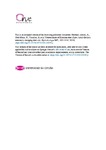Mostrar o rexistro simple do ítem
Determinants of Eurasian Otter (Lutra Lutra) Diet in a Seasonally Changing Reservoir
| dc.contributor.author | Martínez-Abraín, Alejandro | |
| dc.contributor.author | Marí-Mena, Neus | |
| dc.contributor.author | Vizcaíno, Antón | |
| dc.contributor.author | Vierna, Joaquín | |
| dc.contributor.author | Veloy, Carlos | |
| dc.contributor.author | Amboage, Moraima | |
| dc.contributor.author | Guitián-Caamaño, Amanda | |
| dc.contributor.author | Key, Charlie | |
| dc.contributor.author | Vila, Marta | |
| dc.date.accessioned | 2024-01-24T20:32:58Z | |
| dc.date.available | 2024-01-24T20:32:58Z | |
| dc.date.issued | 2020-03-03 | |
| dc.identifier.citation | Martínez-Abraín, A., Marí-Mena, N., Vizcaíno, A. et al. Determinants of Eurasian otter (Lutra lutra) diet in a seasonally changing reservoir. Hydrobiologia 847, 1803–1816 (2020). https://doi.org/10.1007/s10750-020-04208-y | es_ES |
| dc.identifier.issn | 1573-5117 | |
| dc.identifier.uri | http://hdl.handle.net/2183/35130 | |
| dc.description | This is an accepted version of the published document. This version of the article has been accepted for publication, after peer review (when applicable) and is subject to Springer Nature’s AM terms of use, but is not the Version of Record and does not reflect post-acceptance improvements, or any corrections. The Version of Record is available online at: https://doi.org/10.1007/s10750-020-04208-y | es_ES |
| dc.description.abstract | [Abstract] Otter diet in reservoirs is known to experience seasonal changes. We selected a reservoir with a large population of exclusively wintering great cormorants and seasonal changes in stored water volume to test the relative influence of abiotic and biotic factors on otter foraging ecology. DNA metabarcoding of otter spraints revealed a dietary change from autumn to winter. Otters had a diet dominated by the exotic goldfish in autumn, but predated intensively on the native northern straight-mouth nase in winter. This change was likely caused by predation of cormorants on goldfish and to fish biology. Secondly, macroscopic analysis of spraints revealed that otters shifted from a diet dominated by fish (in terms of biomass) to a diet dominated by red swamp crayfish during spring–summer, when the latter became overabundant. As revealed by modelling, this second shift was most likely influenced by the sudden increase in stored water volume in spring, but also by the cumulative effect of cormorant predation on fish during autumn–winter. Macroscopic analyses of otter spraints collected in a second reservoir with no cormorants revealed a lack of seasonality. Hence, the combined influence of both biotic and abiotic factors explained otter diet seasonality in a lentic-water novel ecosystem. | es_ES |
| dc.description.sponsorship | This work received funding from Xunta de Galicia (Grants GRC2014/050 and ED431C 2018/57) and Universidade da Coruña. A Martínez-Abraín was supported by an Isidro Parga Pondal research contract by Xunta de Galicia during the period 2011–2016 | es_ES |
| dc.description.sponsorship | Xunta de Galicia; GRC2014/050 | es_ES |
| dc.description.sponsorship | Xunta de Galicia; ED431C 2018/57 | es_ES |
| dc.language.iso | eng | es_ES |
| dc.publisher | Springer | es_ES |
| dc.relation.uri | https://doi.org/10.1007/s10750-020-04208-y | es_ES |
| dc.rights | © 2020, Springer Nature Switzerland AG | es_ES |
| dc.subject | Diet shifts | es_ES |
| dc.subject | Interspecific competition | es_ES |
| dc.subject | Foraging plasticity | es_ES |
| dc.subject | DNA metabarcoding | es_ES |
| dc.subject | Changes in stored water volume | es_ES |
| dc.title | Determinants of Eurasian Otter (Lutra Lutra) Diet in a Seasonally Changing Reservoir | es_ES |
| dc.type | info:eu-repo/semantics/article | es_ES |
| dc.rights.access | info:eu-repo/semantics/openAccess | es_ES |
| UDC.journalTitle | Hydrobiologia | es_ES |
| UDC.volume | 847 (2020) | es_ES |
| UDC.issue | 8 | es_ES |
| UDC.startPage | 1803 | es_ES |
| UDC.endPage | 1816 | es_ES |
| dc.identifier.doi | 10.1007/s10750-020-04208-y |
Ficheiros no ítem
Este ítem aparece na(s) seguinte(s) colección(s)
-
GI-GIBE - Artigos [75]






